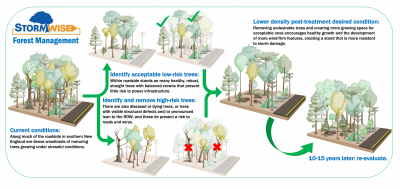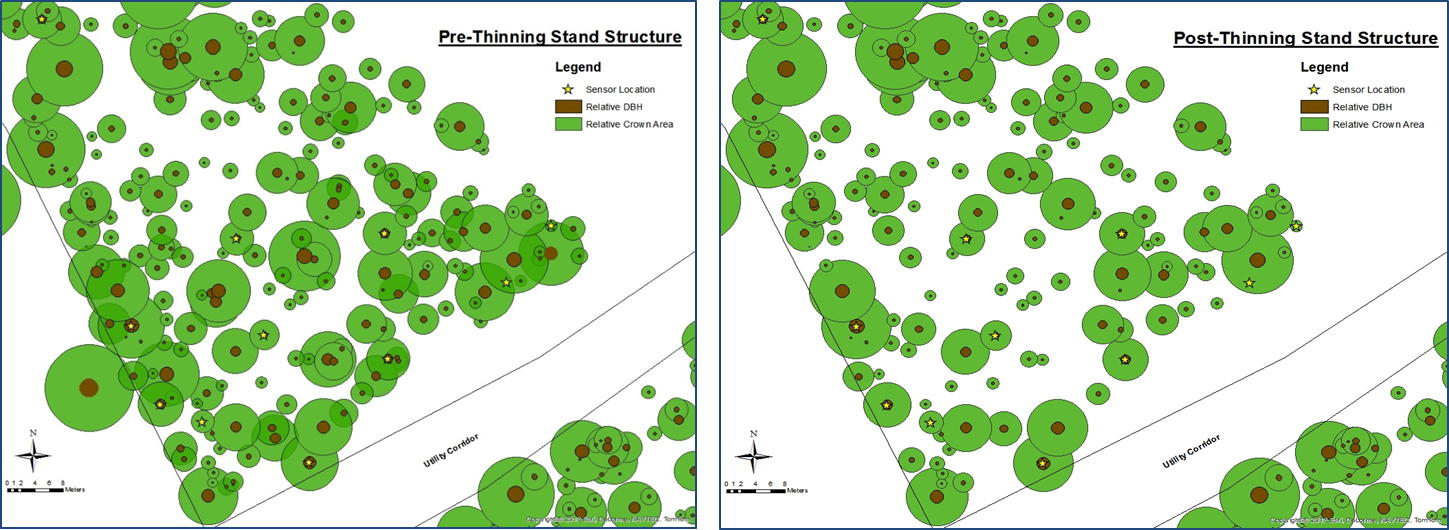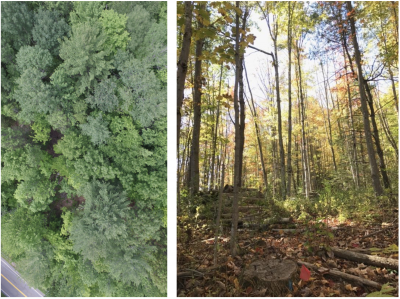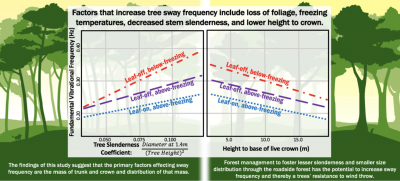Wind And Trees
In 2011, after Tropical Storm Irene hit the northeast in September and was quickly followed by a Nor’easter in October, it was determined that tree failures (branch and stem breakage and uprooting) were responsible for 90% of fallen power lines. If you live in the region and have seen a few roadsides, this might not come as a surprise to you. In southern New England, we have a lot of forest land sharing space with power infrastructure along roadsides throughout the region. Roadside forests average 80 to 100 years old now. Trees are crowded and competing for space and resources. The Stormwise project began in 2012 with a variety of initiatives to address the risk that roadside forests present for electrical infrastructure while simultaneously protecting our valuable trees and forest ecosystems.

The Stormwise project is a multidisciplinary research initiative that looks at the electrical grid, the social context surrounding roadside forests, and forest ecology. The Wind and Trees project, also known as the Biomechanics Projects, is focused on forestry, arborist practices, and the management of the roadside forest. Can we grow trees such that they are less likely to fall on the lines? Can we manage the roadside forest in a way that allows us to maintain all the ecosystem benefits of this exurban greenspace while mitigating the risk to power infrastructure?
The ways that roadside trees sway in the wind – their biomechanical properties – can indicate a tree’s resistance to falling or breaking in extreme wind conditions. UConn forest researchers are monitoring tree sway to better understand these biomechanical properties and the potential for forest management to affect those properties. They track biomechanical properties of trees while foresters and forest scientists experiment with roadside forest management practices in an extensive network of roadside forest sites in Connecticut. The first experiments began in 2012. Recently, we’ve been able to see some of the effects of different practices on the trees and their movement. With careful analysis of these effects, we can develop “best practice” recommendations for roadside forest management. If we manage roadside forests according to these findings, we stand to improve the resistance of trees to wind damage and, at the same time, the resiliency of our power grid in extreme weather!
Through several ongoing studies we continue to improve our understanding of the connections between forest management and biomechanical properties:
Study #1: Biomechanics and forest thinning, initiated in 2012
Healthy trees in open locations seldom fall even in the most extreme wind storms. Open-grown trees do not have to compete for resources, and their constant exposure to weather causes them to develop resistance to storm conditions. Some of this resistance can be seen as large spreading crowns and bushier branching structure to help dispel kinetic energy from the wind, as well as wider bases and a more tapered trunk shape to resist extreme bending.
Conversely, trees growing in a closed-canopy situation have to compete for space, light, water and nutrients. In the unmanaged roadside forests of southern New England they are also stressed by pollutants including road salt, they are exposed to introduced pets and pathogens, and they can develop extreme leans as they seek sunlight over a road or open space. These crowded trees lack the resources or the exposure to develop resistance to wind, and are very susceptible to failure.
In this first study, forest managers will thin the forest, retaining straight and robust trees that will be left with access to more resources as well as new exposure to wind and weather. Ideally this will drive the retained trees to develop more wind-firm features. The first physical changes are likely to happen in the roots where it is difficult to measure change on a living tree, but development of wind-firm features, even below-ground development, will be visible as changes to the biomechanical properties – the way the tree sways in the wind. This long-running experiment is designed to track these changes over time. This research will ultimately be put to use in honing the best practices and forestry prescriptions to recommend to communities for management of roadside forests, and along the way, our improved understanding should help us to improve maps of risk to roadside infrastructure from forest stands with certain properties.

Figure 3: Stormwise forest management prescription for roadside forests.

Figure 4: A tree map of the Biomechanics site in Storrs, showing forest structure before and after a Stormwise thinning

Goals and Project Updates as of Jan. 2022:
41 trees in 3 Connecticut roadside sites are equipped with sensors tracking their movement in all wind conditions. They were monitored for a year before a forest thinning was initiated (starting in 2012), and as of summer 2017 each of the three sites has been thinned and trees continue to be monitored. A meteorological tower was established in the vicinity of each site to monitor wind conditions.
In 2019, tree sway data from before the thinning was analyzed and it was determined that major drivers of tree sway frequency (sways-per-second) included the slenderness (or taper) of the tree, as well as the height from the ground to the base of the live crown (See Bunce et al., 2019). It was expected that these factors of shape would be more important that the specific species of the tree, or the particular wind conditions.
Publication: Bunce, Amanda, John C. Volin, David R. Miller, Jason Parent, and Mark Rudnicki. “Determinants of tree sway frequency in temperate deciduous forests of the Northeast United States.” Agricultural and Forest Meteorology 266 (2019): 87-96

In 2021 data from this experiment was included in a meta-analysis of wind loading on trees from a wide variety of locations and forest types, looking closely at relationships between tree sway frequency and shape characteristics of the tree.
Publication: Jackson, Toby D., Sarab Sethi, Ebba Dellwik, Nikolas Angelou, Amanda Bunce, Tim van Emmerik, Marine Duperat et al. “The motion of trees in the wind: a data synthesis.” Biogeosciences 18, no. 13 (2021): 4059-4072.
The sites were somewhat dismantled in August, 2020, by Isaias which hit the northeast as a tropical storm. Valuable data was gathered during the storm as long as the tree motion could be tracked in the extreme winds. Analyses of that storm data and others, in addition to analyses of the long-term biomechanical responses to thinning are expected to be developed for future publications.
Study #2: Forest Edge Structure and Biomechanics, initiated in 2021
This project seeks to better characterize the structure of roadside stands and look at impacts of common roadside tree trimming practices by combining sway measurements with airborne LiDAR and Terrestrial Laser scanning to model the trees.
- Structural components of roadside trees including crown area, crown density, and crown asymmetry, will be characterized and can potentially help to evaluate the need for trimming.

Tree trimming is the most common method of power companies for of mitigating the risk to power infrastructure presented by roadside trees. Trained arborists are involved in making choices to maintain the health of residual trees and remove branches, or entire trees the present the greatest risk. While this technique has been effective at reducing outages, we recognize that little is known about the impact of tree trimming on the dynamic properties of trees.
The leaves and branches of trees can act as a sail, catching wind and potentially causing the tree to fail. However, branching structures and leaves also act to dissipate kinetic energy from the wind. A quaking aspen, for example, diverts kinetic energy from the trunk, where permanent damage could be done, out through the leaves, which can shake like crazy with little consequence. In what ways does the act of trimming impact the careful balance of energy diversion developed by roadside trees? How is the crown structure of a given tree, or the structure of the surrounding forest canopy, connected to a trees’ biomechanical properties, and in what ways do those properties change after trimming? Can we use this information to make more informed decisions about tree trimming?
- New tilt sensors, using readily accessible microcontrollers and open-source software, are being developed to deploy this study in many new roadside locations.
- Using the new tilt sensors in combination with detailed laser scans of individual trees, this study is intended to investigate the impacts structural diversity of roadside stands on the biomechanical properties & crown characteristics of trees.
- We expect to partner the project with one in New Hampshire investigating drought conditions, which may highlight connections between drought and biomechanical properties.
Goals and Project Updates as of Jan. 2022:
For this project, a new inclinometer is being developed, using widely available Arduino micro-controllers and accelerometers similar to those that sense the tilting in a smart phone. Using these tools we are developing a fairly inexpensive instrument that can be moved from tree to tree to gather data from a number of sites and treatment conditions. Prototypes are being installed on trees around the UConn forest in the winter of 2021/2022, with deployment for new locations planned for the upcoming year.
